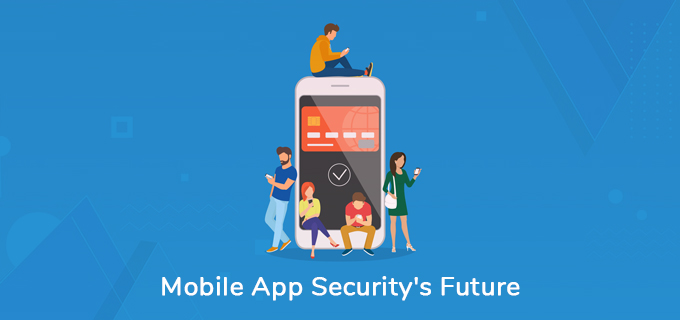The escalating advent of smartphones, together with mobile apps that run on them is probably the largest technical phenomenon recently. Now, smartphones have become our remote control, with things happening in just one tap via numerous apps to choose from, such as booking cabs, playing games, tracking music, and so on. The mobile application industry has seen a boom in such a way that millions of consumers are adopting mobile tech to remain connected.
As innovation and technology advance as well, the need for security has become all the more important. Nevertheless, as technology continues to evolve, neither current nor traditional methods of security simply don’t cut it anymore. Today, mobile app development services are not complete without the right security measures to combat digital attacks.
Currently, technologies such as Business Intelligence, IoT, and AI are emerging and shaping how we do business. Although all these give rise to huge opportunities, it has widened the playgrounds wherein hackers operate as well. We’ve already seen numerous Internet of Things related attacks in the past few years.
Cyber-attacks have even targeted celebrities, the CIA, and other government agencies. Thus, we can say that the future of cybersecurity or mobile app security is profoundly connected with innovations, the introduction, and the adoption of new technologies powering organizations over the web. As the web has become paramount in the lives of millions of people worldwide, it’s of vital importance that organizations address security not only at present but in the future as well.
Common Threats in App Security
Mobile app developers have determined the common factors that are threatening mobile apps across devices.
- Data Leak
Often, mobile applications are the cause of unintentional leakage of data. ‘Riskware’ apps for instance pose a real problem for users who grant wide permissions but don’t check security all the time. These free apps are typically found in official app stores, which work as advertised, but send personal and possibly corporate data to a remote server as well, where it’s mined by advertisers, and in some instances by cybercriminals.
Furthermore, data leak could also occur via unfriendly enterprise-signed mobile applications. A distribution code is used by mobile malware programs, which is native to the popular operating systems, like Android and iOS, for moving valuable data across networks in the company without raising red flags.
- Spoofing a Network
Spoofing a network occurs when hackers set up fake access points; connections that appear as Wi-Fi networks, but are traps, in high-traffic public spaces such as libraries, coffee shops, and airports. Cybercriminals give common names to the access points, such as ‘Coffeehouse’ or ‘Airport Free Wi-Fi’ to lure users to connect. In some scenarios, attackers require users to make an ‘account’ to get free access to services and come complete with a password.
Since a lot of users engage the same combination of email and password for different services, hackers then could jeopardize eCommerce, user email, and other secure information. Aside from being very cautious when connecting to any free Wi-Fi, it’s also a big no-no to provide personal information. Whenever you’re asked to create a login, whether for any app or Wi-Fi, always make a unique password.
- Not Secured Wi-Fi
Nobody wants to use up cellular data when there are hot spots available, but free Wi-Fi’s usually are not secure. There was free wireless security experimentation in which three politicians in Britain agreed to take part, and tech experts easily hacked into their accounts.
Their PayPal, social media, and even VoIP conversations were compromised. To be safe on the safe side, use free Wi-Fi on your mobile device sparingly. Moreover, never use it to access personal or confidential services, such as credit card information or banking.
- Spyware
While a lot of mobile users worry about malware sending data streams back to criminals, a major threat that’s nearer to home is Spyware. In most instances, it’s not the malware from unknown attackers that we should be worried about, but the spyware installed by coworkers, employers, or spouses to keep tabs or our activity and whereabouts. Most of these apps, known also as stalker-ware, are designed to be loaded on the device of the target person without their knowledge or consent.
An extensive malware and antivirus detection suite must utilize specialized scanning methods and techniques for this kind of program, which needs a little different handling than other malware owing to not only getting on your mobile and its purpose.
- Inappropriate Session Handling
For facilitating easy mobile device transaction access, a lot of apps use ‘tokens’ that let users do numerous actions without being pressured on identity re-authentication. Similar to user passwords, apps acquire tokens to identify and validate mobile devices. With every access attempt or session, secure applications generate new tokens and must stay confidential.
Inappropriate session handling happens when applications share session tokens unintentionally, such for instance malicious actors that let them mimic legitimate users. This often is the result of a session that stays open after a user has navigated away from the website or the app. If you logged into the intranet site of the company from your tablet and forget to log out for instance, by remaining open, a cybercriminal could freely explore the site, as well as other connected parts of the network of the organization.
- Phishing
Mobile devices, almost all the time are powered-on, thus they’re the front lines of the majority of a phishing attack. Mobile users are more susceptible since they monitor their email regularly, opening, and reading emails whenever received. Users of mobile devices also are susceptible since email applications display less information to accommodate smaller screens.
Take for instance an email that could only display the name of the sender even when opened, unless you expand the header information bar. Do not click on unfamiliar email links. Furthermore, if it’s not urgent, then allow the action or response items to wait until you’re at your desktop.
- Ruptured Cryptography
Ruptured or broken cryptography could occur when weak encryption algorithms are used by app developers, or if they fail to implement robust encryption properly. In the first scenario, developers could use familiar encryption algorithms regardless of their known susceptibilities to hasten the development process. thus, resulted in the possibility of a motivated attacker to exploit the vulnerabilities for cracking passwords and gaining access.
In the second scenario, developers use algorithms that are highly secure but leave open other ‘back doors’, which restrict their effectiveness. For instance, it may not be possible to crack passwords, but if developers leave code flaws that let attackers make modifications to high-level functions, like receiving or sending text messages, they may not need passwords to create problems. Thus, app developers and organizations should enforce encryption standards before deploying apps.
Mobile App Protection, Best Practices
- Include Identification, Authentication, and Authorization
Authorization, authentication, and APIs add security to an app’s login. Make sure that application APIs provide access solely to parts of the app necessary to lessen vulnerability.
- JavaScript Object Notation or JSON is ideal for encrypted data exchange
- OpenID Connect enables re-use of the same credentials within various domains
- OAuth2 Standard protocol is used for secure connections. Installing the protocol credentials, and then allowing permission between the client and the end-user.
- App Code Security
The best method of protecting the app code is encryption. Stick to well-assisted, modern algorithms integrated with the use of the API encryption.
- App code must be transferable between the device and the operating system
- Source code test to check vulnerabilities
- File size, runtime memory, data usage, performance, and more should be monitored when adding security
- Mobile Encryption Policy Implementation
Some apps release user data with no permission. Here, the protection of data is on a file-by-file basis. The priority should be Key Management.
- Applications must be Secured from the Back-end
Servers must have security measures to protect confidential data and prevent unauthorized access. APIs accessing servers have to be verified before passing from a client to the database and the server of the app.
- Penetration testing, like testing a web app or network must be done through consulting a network security specialist to ensure the protection of data.
- The containerization method helps to store data and documents securely.
- Encrypting with Secure Sockets Layers, a Virtual Private Network, Transport Layer Security, and add application security too.
- Robust Strategy for API Security
Solid APIs are the main channel for data and content and functionality. Making certain of the right API security is critical. The main security methods in the API security stack include identification, authentication, and authorization.
- Internal Resources’ Protection
Resources that don’t need access to the public internet must be restricted with firewall rules and network segmentation. Compromising the administration, or other resources could lead to severe damage.
- Repeated App Software Testing
The most critical step in mobile app development services. When testing an app, ensure that security is tested together with functionality and usability tests. Emulators for devices, operating systems, and browsers allow you to test the performance of an app.
- Increasing the Complexity of Code
Internally making your app more complex makes it harder for hackers to attack it.
- Implementing App Transport Security or ATS
Ensure secure connections between an app and the back-end server. When you enable the ATS, HTTP connections are pressured to use HTTP, and attempts in connecting with devices the use of an insecure HTTP would fail.
- Avoid Crash Logs and Caching App data
Developers could configure both iOS and Android devices by preventing HTTP caching. Moreover, avoid page data caching and URL history for any application processes. With crash logs, make sure that apps releases are created without warnings, and tested to prevent crashes.
Mobile App Security Predictions in 5 Years
Predictions on things may seem fancy and catch attention, but with cybersecurity, it could spell the difference in terms of saving huge amounts of money and assets, or in most cases, your business. A mobile app development company like eTatvaSoft knows the heavy reliance of businesses and organizations on the Internet and the evolving technology trends. App development service providers know that in the future, there would be more devices connected to the web.
The following are predictions of what mobile app security would be like in five years.
Organizations and their Internet Dependency
Nowadays, most of the systems we do business with are interconnected and driven by the internet. Studies on the technology trends suggest that in the foreseeable future, interconnectedness would only get tighter. More and more devices and organizations would be connected to the web to power processes.
Cyber-attacks would continue, thus stay on guard
In the years to come, organizations would continue developing cyber-attack technologies for defense as well as offense. Unscrupulous people would continue finding ways for cyber-attacks monetization, and terrorist groups would also shift to cyberspace. Moreover, people without obvious motive, who seek to demonstrate their technical know-how and skills would somehow continue to ‘contribute’ to the ecosystem of attackers.
Another issue we would encounter in cyber defense is that not like the physical world where we sort of have an idea of who our potential enemies are and their weapons, in cyberspace, anyone could be the enemy. People are accessible from every corner of the globe, and it was demonstrated already that any attackers could access weapons that don’t need infrastructure or the cost of conventional weapons at all.
Last but certainly not least, a lot of cyber-attacks are automatically run by ‘bots’, which scan an entire network and find the weakest spot, thus we need not appear like an ‘attractive’ target, just a vulnerable point. Yes, all of us are indeed targets.
Automating Decision
Technology innovation allows organizations to lower headcount and automate a lot of decisions. Shortly, we would see a rise in the number of decisions that would be automated. Using personal assistants to do work has been creeping in gradually and adopted by a lot of consumers all over the world.
We would be witnessing evolving versions of automated assistants, and our lives would tend to become very reliant on it. On the other hand, the Internet of Things connected devices would become a part of almost every function of our day-to-day lives. Our daily commute would be so much easier with connected cars, and virtually all our data would live in cloud computing, where we have no full control of the access to information and the flow of data.
The connectivity and complexity of these systems impact their vulnerability level directly. Some may argue that to be able to protect our systems, we should understand the motive of the hackers. The truth, however, is that we would never be able to determine the motive of a hacker. It seems that everyone hacks for a different reason.
Protocols in Security
Cybersecurity defense systems should be more sophisticated to cope with the gigantic amount of data. First things first, we have to interconnect defense systems to act and work in real-time. Consider, for example, a network gateway that would have to share information with people’s devices.
The second is that a human analyst would not be able to cope with all the information and there would be more reliance on Artificial Intelligence to help in decision making. Moreover, it’s important to cultivate cyber experts of the next generation who know how to build and drive the systems. Domain expertise and new professions would be formed.
The last thing of course is shielding all our systems. States and countries would have a larger role in big-scale environment protection, the same as their infrastructure, such for instance water supply, traffic control, power grids, and just about everything around, and perhaps to provide some of their intelligence to the public as well. Big companies would have to guard their data within their servers, on their cloud servers, our personal computers, and on our mobile devices. Although we could have the most secure data center, if data manages to leak through a mobile device or even a cloud provider, then we’re just as susceptible.
Conclusion
A lot of organizations and consumer mobile apps work on one device, but they seem to act independently with various functions. Without the right security built-in mobile apps, however, data hacking and hidden integrations could lead to a great possibility of the occurrence of data hacking. Some people may think that cyber-attacks occur only in giant corporations.
The reality however is that all of us are at risk even while we do something as simple as downloading a mobile application on our mobile devices. The best practices should always be followed then and of course, relying on security experts to keep apps safe from threats is paramount. Being aware of how the security of mobile apps would be in the next five years is critical to build more secure solutions, and to find ways to protect our critical information more effectively.
























